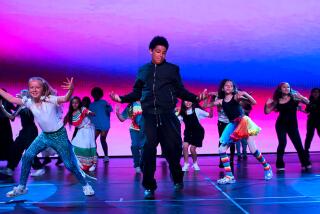AT N.Y. CITY CENTER : TRI-STAR <i> GLASNOST </i> AT GRAHAM GALA
- Share via
NEW YORK — Though simply called the Martha Graham Gala, the event held at New York City Center on Tuesday night to mark the opening of the Martha Graham Dance Company’s three-week season could have been billed as Graham glasnost.
By presenting Maya Plisetskaya, Rudolf Nureyev and Mikhail Baryshnikov on the same program, Graham, 93, was trading in her own way on the glasnost, or openness, promoted by Soviet leader Mikhail S. Gorbachev.
Since Baryshnikov and Nureyev are Soviet defectors, allowing Plisetskaya, who remains a Soviet citizen, to appear in a high-profile gala performance with them would have been unthinkable until recently . Nearly as unthinkable little more than a decade ago would have been the likelihood of Graham--the virtual mother of American modern dance--highlighting in her fold three of Russian ballet’s most emblematic stars.
In the end, Plisetskaya performed in a solo piece separate from another work in which both Nureyev and Baryshnikov participated.
Plisetskaya’s performance of “The Incense,” a 1906 solo originally created by Graham’s mentor Ruth St. Denis, was dutiful but not exactly mesmerizing. Swathed in a pretty pink-and-gold sari, the Bolshoi ballerina went through the statuesque poses and undulating arm movements as if she were still investigating the logic of the solo.
It wasn’t until her curtain-call reaction to her adoring audience’s applause that she showed both the ease and conviction of body plastique which allowed her to communicate personally and potently to everyone in the full theater.
As the Revivalist and Husbandman respectively in Graham’s 1944 “Appalachian Spring,” Nureyev and Baryshnikov each had solid success. It was Nureyev who first inspired Graham’s openness, some 12 years ago, when he was invited to explore roles in the Graham repertory. Dancing the role of the eccentric and fiery preacher as he has on other occasions, Nureyev remained alert to Graham’s shaping of the part while endowing the character with some sly strains of his very own.
Baryshnikov, who was dancing Graham’s work for the first time, created a character whole and alive. By balancing the scrupulous way he shaped and held maneuvers that were not second nature to him with the personal way he colored their character, the evening’s junior Russian showed how workable classical dance habits are. In the middle of his most extended solo passage, Baryshnikov’s boot-shod newlywed beamed most brightly and naturally, as he reaped the newfound pleasures gained from plumbing Graham’s choreography to its center.
In between the appearances of her guests, Graham herself was shown dancing in “Frontier,” a 1935 solo, by means of a rarely seen film that dates from sometime just after the work’s premiere.
The once silent footage, originally intended as an archival record of the choreography, has recently been given a sound track of the work’s Louis Horst score and now exists as a decent document of Graham’s dance and her own dancing. In plain and somewhat pale black-and-white, it showed a simplicity, a monumentality and a focus all too often absent from the work of the present Graham company.
Such an absence was unfortunately apparent on much of the rest of the nine-part program. With isolated exceptions--Denise Vale, for one, who performed with notable conviction in “Serenata Morisca,” a 1916 dance originally choreographed by Ted Shawn for Graham herself--most of the company showed a lack of central focus in their dancing and delivered material in pieces rather than of a piece.
Graham’s openness to ballet dancers was once thought to be heresy, or at least a stunt. On this program her three classically schooled guest artists showed that a differently located center is preferable to next to none at all.
More to Read
The biggest entertainment stories
Get our big stories about Hollywood, film, television, music, arts, culture and more right in your inbox as soon as they publish.
You may occasionally receive promotional content from the Los Angeles Times.










